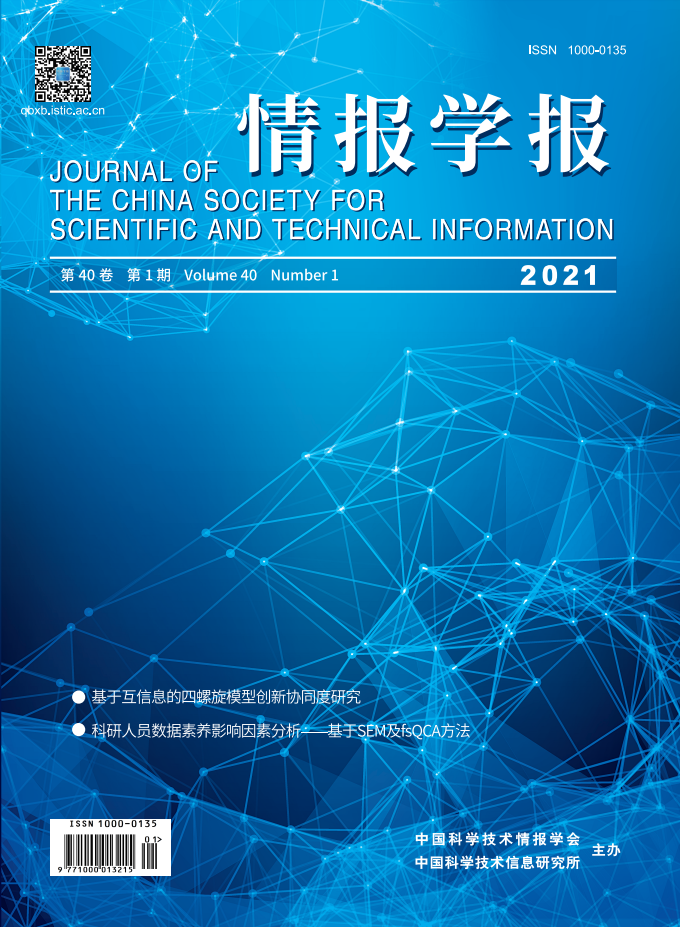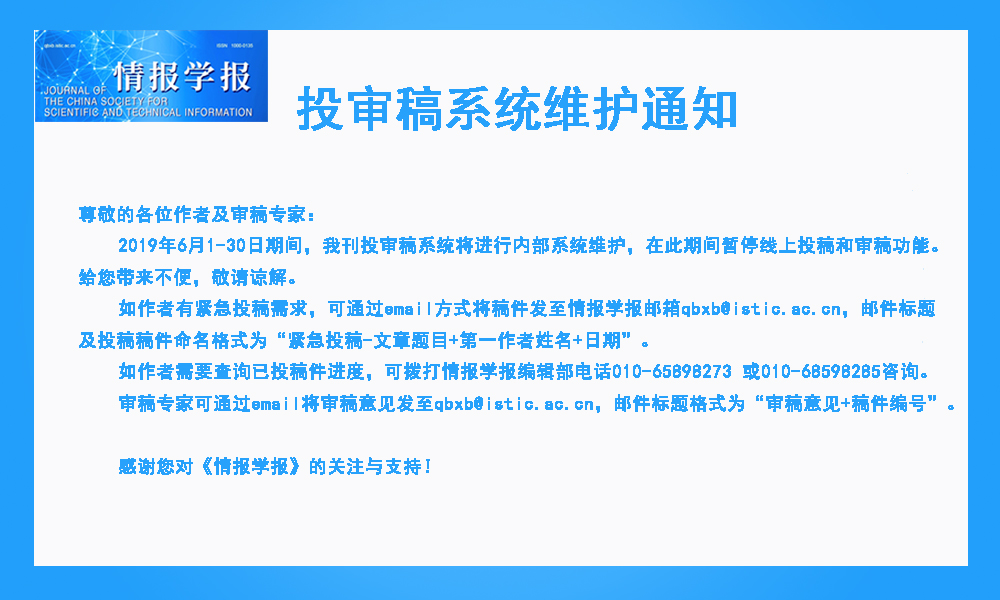 |
|
2021 Vol. 40, No. 1
Published: 2021-01-24 |
|
|
| |
|
|
|
|
|
1 |
Innovation Synergy of a Quadruple-Helix Model Based on Mutual Information Hot! |
|
 |
Xiao Guohua, He Defang, Zhang Xian, Xu Haiyun, Han Ye |
|
|
DOI: 10.3772/j.issn.1000-0135.2021.01.001 |
|
|
This study analyzes the limitations of the triple-helix model of government-industry-research institution and the shortcomings of the existing research on the fourth helix. It introduces the viewpoint that the science and technology (S&T) service organization should be the fourth helix, and thus builds the quadruple-helix model of government-industry-research institution-service organization. Subsequently, an index of Tgias quadruple-helix innovation synergy is designed based on mutual information and the triple-helix algorithm. The output data of scientific and technological papers on each subject are used as its innovation output characterization, and the innovation synergy between and among the quadruple-helix subjects with the index Tgias are quantitatively measured. Quantitative analysis reveals that after the S&T service organization joins the helix structure, the existing synergies of government-industry, government-research institution, industry-research institution, and government-industry-research institution are comprehensively improved, reflecting the catalytic and promoting role of such organization as the fourth helix in the innovation and development of the original triple-helix system. The research and application of the model developed herein is conducive to improving the efficiency of collaborative innovation in S&T intelligence, technology transfer, and other aspects. |
|
|
2021 Vol. 40 (1): 1-10
[Abstract]
(
527
)
HTML
(1 KB)
PDF
(2647 KB)
(
805
) |
|
|
|
11 |
Analysis of Factors that Influence Researchers' Data Literacy Using SEM and fsQCA Hot! |
|
 |
Bi Datian, Cao Ran |
|
|
DOI: 10.3772/j.issn.1000-0135.2021.01.002 |
|
|
The advent of the era of big data has been marked by the acquisition, analysis, use, and sharing of scientific data. Researchers' data literacy is playing a crucial role in maximizing the use of scientific data. Therefore, a comprehensive analysis of the factors that influence researchers' data literacy can better promote the utilization of scientific data and give play to its maximum value. This study used the structural equation model in a questionnaire survey to verify the hypothesis, and conducted a qualitative comparative analysis to explore the impact of factor combinations on data literacy. The results of the analysis show that education and training, technology platform, and literacy atmosphere significantly affect researchers' attitude toward scientific data literacy; education and training, literacy atmosphere, and attitude significantly affect the scientific data literacy of researchers; education and training, technical platform, and literacy atmosphere can have a positive impact on data literacy through attitude; high education background and positive attitude, or high education background, high education and training, low technology platform, low literacy atmosphere are the pre-requisites of high scientific data literacy. |
|
|
2021 Vol. 40 (1): 11-20
[Abstract]
(
492
)
HTML
(1 KB)
PDF
(1598 KB)
(
1342
) |
|
|
|
21 |
Time-lag Calculation and Enlightenment of Multi-source Science and Technology Literature Fusion for the Detection of Emerging Research Topic: A Case Study in the Field of Agriculture Hot! |
|
 |
Yang Jinqing, Lu Wei, Wu Leyan |
|
|
DOI: 10.3772/j.issn.1000-0135.2021.01.003 |
|
|
To explore the time lag in the emerging topic detection of multi-source data fusion, this paper designs a scheme to calculate time lag. First, research topics are extracted from four kinds of scientific and technological literature datasets, then a similarity matrix is constructed by calculating the similarity between those research topics. Second, optimal combination under the condition of minimum similarity loss is found based on the Hungarian optimal matching algorithm. Finally, the linear equation model is constructed and time lag is calculated by fitting the model. Using the experimental data of 337,790 abstract texts in agricultural disciplines from 2009 to 2016, the number of the research topics extracted from fund projects, patents, journal articles, and conference papers is 250, 260, 260, and 240 respectively. Using the above-mentioned time-lag calculation method of scientific and technological literature, we find the following results: journal articles lag behind fund project text and conference papers for one year and patent documents lag behind journal articles for one year. Combining with the previous research results in different disciplines, the feasibility and effectiveness of the time-lag calculation method for multi-source scientific and technological literature are verified, and a new idea for the formulation of a multi-source data fusion strategy is also provided. |
|
|
2021 Vol. 40 (1): 21-29
[Abstract]
(
186
)
HTML
(1 KB)
PDF
(1984 KB)
(
817
) |
|
|
|
53 |
Technology Opportunity Identification Based on RFM Model and Stochastic Actor-oriented Model Hot! |
|
 |
Zhang Zhengang, Luo Taiye |
|
|
DOI: 10.3772/j.issn.1000-0135.2021.01.006 |
|
|
Technology opportunity identification is very significant to the innovation management of R & D organizations. Taking the patent data from 2013 to 2015 in the field of artificial intelligence as an example, this study proposes a novel method to identify technological opportunities. Using the idea of RFM (recency, frequency, monetary) model, we employed the K-means algorithm to cluster knowledge elements based on three indicators (i.e., length of the average occurrence time, frequency of occurrence, and combination capacity) and yielded four knowledge elements that could reflect the direction of technology development in the field. The stochastic actor-oriented model was used to analyze the evolution of knowledge networks, and a formula was proposed to discover new technology opportunities for knowledge elements. Using this formula, we predicted the potential technology opportunities for the four yielded knowledge elements. The validity of the proposed method was tested by using the patent data of 2016-2018 in the field. The robustness of the proposed method was also tested by using the patent data from 2014 to 2018 in the field of 3D printing. |
|
|
2021 Vol. 40 (1): 53-61
[Abstract]
(
349
)
HTML
(1 KB)
PDF
(2638 KB)
(
930
) |
|
|
|
77 |
Motivation, Source Selection, and Behavior Path of Cross-Source Health Information Seeking Hot! |
|
 |
Li Yuelin, Wang Shanshan, Ruan Mei |
|
|
DOI: 10.3772/j.issn.1000-0135.2021.01.008 |
|
|
This study aims to explore users' cross-source health information seeking behavior, especially motivation, source selection, and behavior path when facing various sources of health information. The data were collected from the diaries and semi-structured in-depth interviews of 26 participants. Open coding was performed to analyze the data. The results indicate that communication barriers with doctors, lack of trust, self-regulation, and psychological safety are the motivations of cross-source health information seeking behavior. Personal statement of similar symptoms from other patients, dependent and habitual path, conformity, authority, and credibility of information sources are main factors that impact users’ choice of source. In particular, some features, such as the necessity of psychological needs during the seeking process and the perceiving of the quality of information by “feelings,” are typical during the course of cross-source health information seeking. The study proposes a model to describe the behavior path of cross-source health information seeking, which can help users to improve their cognitive behavior, capability to access information, and health information literacy. In addition, it can also help relevant departments to develop strategies to improve users' health information literacy and assist health information systems to develop some mechanisms to support cross-source information seeking. |
|
|
2021 Vol. 40 (1): 77-87
[Abstract]
(
449
)
HTML
(1 KB)
PDF
(2100 KB)
(
1255
) |
|
|
|
88 |
Spiral and Linear: Interaction Patterns between User and Doctors on an Online Health Platform Hot! |
|
 |
Li Yuelin, Zhang Jianwei, Zhang Hua |
|
|
DOI: 10.3772/j.issn.1000-0135.2021.01.009 |
|
|
With the development of the Internet, patients (or patients’ agents, called “users” in this study) seek medical information or treatment suggestions by interacting with doctors through online health platforms or systems. This study concerns effective improvements to user-doctor interactions in a virtual environment in the absence of face-to-face communication and attempts to identify interaction patterns and features. For that reason, 1017 sets of user-doctor conversations were collected from “Doctor Chunyu” by a data crawler. Open coding and conversation analysis were used to analyze the data. This study identifies two interaction patterns, spiral and linear patterns, and develops a theoretical model for each pattern. In addition, the result indicates that the degree of clarification of the initial description of symptoms at the beginning of a conversation is a key factor that affects interaction efficiency between users and doctors. This study helps us understand how to improve the interaction efficiency between users and doctors on online health platforms, optimize user interaction design, and provide empirical evidence for future research on online intelligent interactive health platforms. |
|
|
2021 Vol. 40 (1): 88-100
[Abstract]
(
362
)
HTML
(1 KB)
PDF
(3166 KB)
(
1122
) |
|
|
|
101 |
Research on Collaborative Tagging Behavior Mechanisms Based on Collective Intelligence Theory Based on Douban Movie Tag Data Hot! |
|
 |
Yi Ming, Feng Cuicui, Mo Fuchuan, Deng Weihua |
|
|
DOI: 10.3772/j.issn.1000-0135.2021.01.010 |
|
|
Based on the theory of collective intelligence, this study constructed a collaborative tagging behavior model. The collaborative tagging behavior included three sub-processes: the initial stage, intermediate stage, and ultimate stage at the macro level, and three sub-steps: divergence, convergence, and cohesion at the micro level. The macro level described the process of collaborative information organization behavior from quantitative change to qualitative change, highlighting the process of collaborative tagging behavior; and the micro level described the basic process of the emergence of group intelligence in collaborative tagging behavior, highlighting the synergy of collaborative tagging behavior. Empirical analysis based on Douban movie tag data found that the collaborative tagging behavior model reasonably explained the process and synergy of collaborative tagging behavior. The skew coefficient of tag labeling times generally increased, and the collective intelligence kept emerging during the process of collaborative tagging behavior. Tag citation was the normal status of the entire collaborative tagging behavior process, leading to the formation of a stable, high-frequency tag group that represented the opinions of the group users. The eight patterns of collaborative tagging behavior occurred throughout the entire process of collaborative tagging behavior, but the convergence mode was relatively stable, and the divergence mode will join the convergence mode with high probability. The collaborative tagging behavior process was dominated by convergence, which showed that the group users’ opinions made a transition from divergence to convergence, and finally condensed to achieve a global consensus. The results showed that the theoretical model and research methods of this paper are scientific, and can enrich the theory and method of collaborative information behavior. |
|
|
2021 Vol. 40 (1): 101-114
[Abstract]
(
436
)
HTML
(1 KB)
PDF
(3317 KB)
(
898
) |
|
|
|


